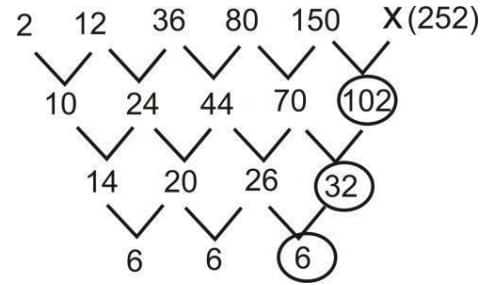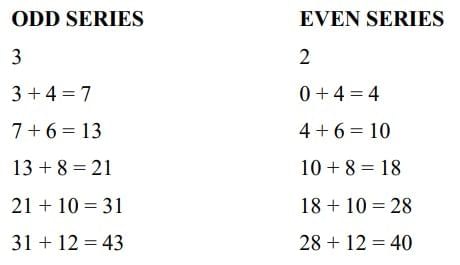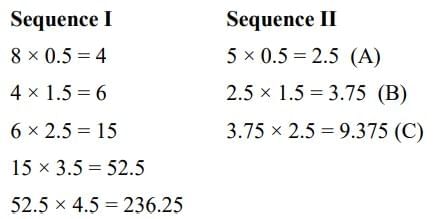Previous Year Topic Wise Questions With Solutions: Series | CSAT Preparation - UPSC PDF Download
Q1. What is X in the sequence 24, X, 12, 18, 36, 90? (2025)
(a) 18
(b) 12
(c) 9
(d) 6
 View Answer
View Answer 
Ans: (b)
The pattern is:
24 × 0.5 = 12
12 × 1 = 12 (X)
12 × 1.5 = 18
18 × 2 = 36
36 × 2.5 = 90
It appears that the multiplier is increasing by 0.5 each time. So, the missing term is 12.
Q2. Consider the sequence A_BCD_BBCDABC_ DABC_D that follows a certain pattern.
Which one of the following completes the sequence? (2024)
(a) B, A, D, C
(b) B, A, C, D
(c) A, A, C, D
(d) A, A, D, C
 View Answer
View Answer 
Ans: (c)
Given sequence: A_BCD_BBCDABC_DABC_D The required sequence is:
A A BCD / A BBCD / ABC C D / ABC D D
Hence, the missing letters are – A, A, C, D
Q3. What will come in place of * in the sequence 3, 14, 39, 84, *, 258? (2024)
(a) 150
(b) 155
(c) 160
(d) 176
 View Answer
View Answer 
Ans: (b)
Given series: 3, 14, 39, 84, *, 258
The series follows the following pattern: 13 + 12 + 1 = 3
23 + 22 + 2 = 14
33 + 32 + 3 = 39
43 + 42 + 4 = 84
* = 53 + 52 + 5 = 155
63 + 62 + 6 = 258
Thus, missing number is 155.
Q4. Let pp, qq and rr be 2 digit numbers where p < q < r. If pp + qq + rr =tt0, where tt0 is a 3-digit number ending with zero, consider the following statements:
1. The number of possible values of p is 5.
2. The number of possible values of q is 6
Which of the above statements is/are correct? (2023)
(a) 1 only
(b) 2 only
(c) Both 1 and 2
(d) Neither 1 nor 2
 View Answer
View Answer 
Ans: (c)
tt0 is a 3-digit number ending with zero, such that pp + qq + rr = tt0
As pp, qq, and rr are 2-digit numbers, the value of tt0 can be either 110 or 220. Thus, we get:
If tt0 = 110
pp + qq + rr = 110
or (10p + p) + (10q + q) + (10r + r) = 110
or 11p + 11q + 11r = 110
or p + q + r = 10 ……. (1)
If tt0 = 220
pp + qq + rr = 220
or (10p + p) + (10q + q) + (10r + r) = 220
or 11p + 11q + 11r = 220
or p + q + r = 20 ……. (2)
Statement 1:
As p < q < r, the possible value of p in equation (1) can be 1 and 2.
As p < q < r, the possible value of p in equation (2) can be 1, 2, 3, 4 and 5.
Hence, the number of possible values of p is 5.
Thus, Statement 1 is correct.
Statement 2:
As p < q < r, the possible value of q in equation (1) can be 2, 3 and 4.
As p < q < r, the possible value of q in equation (2) can be 6, 7 and 8.
Hence, the number of possible values of q is 6.
Thus, Statement 2 is correct.
Hence, option (c) is correct.
Q5. What is the value of X in the sequence 20, 10, 10, 15, 30, 75, X? (2022)
(a) 105
(b) 120
(c) 150
(d) 225
 View Answer
View Answer 
Ans: (d)
The given series is: 20, 10, 10, 15, 30, 75, X?
The terms are decreasing in the initial half, and then they start increasing. The speed at which they increase at the latter half suggest that multiplication may be involved.
The pattern is as follows:
20 × 0.5 = 10
10 × 1 = 10
10 × 1.5 = 15
15 × 2 = 30
30 × 2.5 = 75
75 × 3 = 225
Q6. In the series AABABCABCDABCDE.., which letter appears at the 100th place? (2022)
(a) G
(b) H
(c) I
(d) J
 View Answer
View Answer 
Ans: (c)
The given series is: AABABCABCDABCDE…
The pattern being followed here is: A, AB, ABC, ABCD, ABCDE, …
It’s kind of an arithmetic series wherein the first term has 1 letter, second term has 2 letters, and so on.
We have to estimate the length of the letter-series near the 100th letter.
If we have an arithmetic series, 1, 2, 3 …, then:
Sum of first n terms = (n/2) (a + l), where ‘n’ is the number of terms in the series, ‘a’ the first term, and
‘l’ the last term.
So, sum of first 14 terms = (14/2) (1 + 14) = 7 × 15 = 105
So, the term having 14 letters will have the 100th letter of the series.
It will start at the 92nd letter and end at 105th letter. Hence, the 100th letter must be I.
Q7. What is the value of X in the sequence 2, 12, 36, 80, 150, X? (2022)
(a) 248
(b) 252
(c) 258
(d) 262
 View Answer
View Answer 
Ans: (b)
The pattern has been represented below: Hence, option (b) is the correct answer.
Hence, option (b) is the correct answer.
Q8. Replace the incorrect term by the correct term in the given sequence
3, 2, 7, 4, 13, 10, 21, 18, 31, 28, 43, 40
where odd terms and even terms follow the same pattern. (2021)
(a) 0
(b) 1
(c) 3
(d) 6
 View Answer
View Answer 
Ans: (a)
On separating the Odd and the Even Series, we observe the following pattern:
On observing the given two series, we observe that the first term in EVEN SERIES should be replaced by 0, therefore option (a) is the correct answer
Q9. You are given two identical sequences in two rows: What is the entry in the place of C for the Sequence-II? (2021)
What is the entry in the place of C for the Sequence-II? (2021)
(a) 2.5
(b) 5
(c) 9.375
(d) 32.8125
 View Answer
View Answer 
Ans: (c)
The inherent pattern in the two sequences has been represented below. 
Q10. In the series_b_a_ba_b_abab_aab; fill in the six blanks (_) using one of the following given four choices such that the series follows a specific order. (2021)
(a) bababa
(b) baabba
(c) bbaabb
(d) ababab
 View Answer
View Answer 
Ans: (d)
The given series is: _b_a_ba_b_abab_aab
The pattern being followed in the above series is: abb, then aab. Again abb, and then aab, and so on.
The blanks have been highlighted below:
a b b / a a b / a b b / a ab / ab b / aab
Q11. What is the value of ‘X’ in the sequence 2, 7, 22, 67, 202, X, 1822? (2021)
(a) 603
(b) 605
(c) 607
(d) 608
 View Answer
View Answer 
Ans: (c)
The given sequence is 2, 7, 22, 67, 202, X, 1822
The pattern being followed here is given below:
2 × 3 + 1 = 7
7 × 3 + 1 = 22
22 × 3 + 1 = 67
67 × 3 + 1 = 202
202 × 3 + 1 = 607
607 × 3 + 1 = 1822
|
208 videos|272 docs|138 tests
|
FAQs on Previous Year Topic Wise Questions With Solutions: Series - CSAT Preparation - UPSC
| 1. What are the common types of questions asked in the UPSC examination related to series? |  |
| 2. How can candidates effectively prepare for series questions in the UPSC exam? |  |
| 3. Are there any specific strategies to solve numerical series questions quickly in the UPSC exam? |  |
| 4. What role does logical reasoning play in the series questions of the UPSC exam? |  |
| 5. How often do series questions appear in the UPSC examination, and what is their weightage? |  |
















